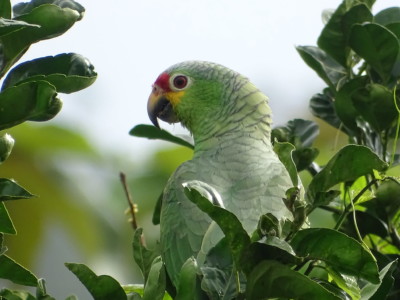December 20, 2022
We got a deal from Montreal COP15 – then what?
I had the privilege to attend Montreal COP 15 as a member of the Finnish delegation. The trip was an enlightening experience, and all my respect goes to the negotiators who have been pushing for the agreement for years in preparation, and finally, in the final stages for weeks with very little sleep – and even food.
As you have probably noticed, we have a global biodiversity agreement now, which is of course good news. It did not come out easily though, and there were moments when it felt like the package was on a razor’s edge. The outcome is not perfect but as one experienced negotiator put it, it’s a good consensus agreement where nobody is fully happy.
Good enough agreement

Amazona autumnalis in Siuna, Nicaragua. Photo: MLR Forestal
So, we got our “Paris moment for Nature” but it will only be such if the agreement leads to real implementation activities. We have had global biodiversity agreements before, but the world has failed to deliver those promises., We cannot afford it to happen this time. The target year of this agreement is only eight years away in 2030, meaning that implementation should have started yesterday.
As this was my first COP, I have to rely on other people’s assessment, but everybody was impressed by the private and financial sectors’ strong presence and activism in the meeting. Three bustling private and finance sector days were full of program and side events. I was positively surprised by the initiatives taken already to move towards a green and sustainable economy, and the spirit that even though it’s not perfect yet, we need to act now and not tomorrow.
However, many companies and financiers were not present. We must drag them along to the transformation of the world economy, with the support of the agreement achieved.
Transparency to drive the change
The private and financial sectors were strongly campaigning for “Make it mandatory” to promote mandatory assessment and disclosure of nature-related data in large companies and corporates. The initiative aimed to have an agreement that results in fair competition for business, increased accountability, and engagement of investors.
Increased transparency is then expected to empower consumers, involve SMEs through supply chains, and help ensure the rights of indigenous peoples and local communities. The Agreement achieved does not quite follow the formulation of the campaign, but the private sector’s voice is coming through Targets 14 and 15. Biodiversity is expected to be integrated into policies and regulations, and national accounting (Target 14) and legal measures will be taken to “encourage and enable business”, and to ensure that large and transnational companies and financial institutions will also monitor, assess, and disclose their risks, dependencies and impacts on nature (Target 15).
As a result, the agreement is indeed a good step towards a more level playfield for businesses. Forerunners will benefit from voluntary disclosure frameworks such as Taskforce on Nature-related Financial Disclosures (TNFD).
Money, money, money
As expected, maybe the largest challenge throughout the negotiation process was money: Who should pay, how much, and which mechanisms should be used. Annual financing for biodiversity should be USD 200 billion, part of this coming from doing away with harmful subsidies.
However, implementation of Target 19 will not be easy but private sector engagement is expected as Target 19 for the financing of the Agreement makes reference to “from all sources” and “Leveraging private finance, promoting blended finance, (…) encouraging the private sector to invest in biodiversity, including through impact funds and other instruments”. How this encouragement will take place is to be seen.
Another game of arm-twisting was linking climate financing and biodiversity financing, but finally, recognition of synergies made it to the agreement on a broad level with a statement of “Optimizing co-benefits and synergies of finance targeting the biodiversity and climate crises”.
Agriculture and forestry at the forefront of transformation
Facts demonstrate that the agricultural sector is the main driver behind the nature crisis, which is also reflected in the agreement. Agriculture and forestry are Finnfund’s key sectors, so we expect that our work to support sustainable agriculture and forestry is now becoming more and more mainstream. The experiences and models that our investee companies have been developing and implementing will be scaled up.
Target 10 heavily emphasizes sustainable agriculture, aquaculture, fisheries, and forestry, and combined with Target 7 (reduction of pesticides, hazardous chemicals, and excess nutrient loss) and Target 18 (eliminate harmful subsidies and scale up positive ones), is likely to have a transformational impact especially on the agricultural but also on the forestry sector. Support (i.e. subsidies) will be necessary to help farmers in the transition process, and subsidies within the agricultural sector should be transferred to serve this transition.
Implementation of the agreement will also mean that better landscape-level planning is needed in the agriculture and forestry sectors to support conservation and restoration objectives (Targets 2 and 3). At some point, these targets may also lead to compensation mechanisms and biodiversity credit markets, but these mechanisms are still very immature and include even greater risk for greenwashing than we have seen with carbon credits.
Let’s do it!
Concrete numeric targets of halving the global footprint of production and consumption globally did not make it to the agreement, but that is something that each and every individual in the western world must take as a matter of course. So as the first step, let us leave those last-minute Christmas presents at the store.
Happy holidays (for those celebrating) and as a New Year’s promise, let us make the Agreement a reality, starting with ourselves!
Anne Arvola
Senior Development Impact Adviser, Finnfund
Read more:
Finnfund and MLR Forestal to work on an innovative biodiversity remediation programme in Nicaragua – Finnfund
Anne Arvola: We need ambitious targets for nature and biodiversity – Finnfund
Impact – Finnfund
We are biodiversity – Finnfund
